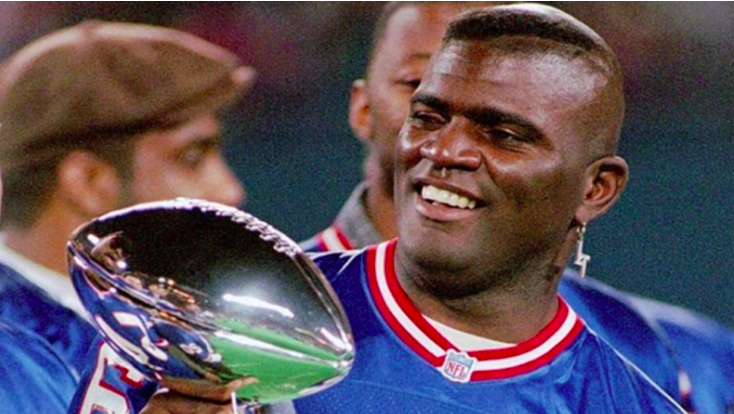Football
Lawrence Taylor: The Linebacker Who Revolutionized Football

Lawrence Taylor: The Linebacker Who Revolutionized Football
When discussing the most transformative figures in NFL history, Lawrence Taylor inevitably commands a central position. Known for his unparalleled athleticism and relentless pass-rushing ability, Taylor redefined the linebacker position, leaving an indelible mark on the game. As a two-time Super Bowl champion and the only defensive player to win the MVP award, his impact is undeniable. This comprehensive exploration will delve into Taylor’s life, career, and legacy, illustrating why he remains one of the greatest football players of all time.
Early Life and College Career
Growing Up in Williamsburg, Virginia
Born on February 4, 1959, in Williamsburg, Virginia, Lawrence Taylor’s early years were shaped by a blend of raw talent and fierce determination. Despite his initial interest in baseball, Taylor’s physical prowess and competitive spirit soon found a natural fit in football.
Dominating at the University of North Carolina
Taylor attended the University of North Carolina, where he quickly made a name for himself. Transitioning from defensive end to linebacker, Taylor’s explosive style of play and instinctive understanding of the game garnered national attention. His senior year performance earned him unanimous All-American honors and set the stage for a storied NFL career.
NFL Career: A New Era for Linebackers
Drafted by the New York Giants
In the 1981 NFL Draft, Lawrence Taylor was selected second overall by the New York Giants. His arrival marked a turning point for the franchise and the linebacker position. Taylor’s rookie season was nothing short of spectacular, earning him Defensive Rookie of the Year and establishing him as a force to be reckoned with.
Revolutionizing the Pass Rush
Taylor’s ability to pressure the quarterback revolutionized defensive strategies in the NFL. His combination of speed, power, and agility allowed him to disrupt offenses in ways previously unseen. Taylor’s relentless pursuit of the quarterback not only resulted in numerous sacks but also forced hurried throws and turnovers.
Impactful Seasons and Super Bowl Victories
Taylor’s career was punctuated by numerous standout seasons. His dominance on the field led the Giants to two Super Bowl victories (XXI and XXV), with Taylor playing a crucial role in both campaigns. His performance in the 1986 season, where he recorded 20.5 sacks, earned him the NFL MVP award, a rare feat for a defensive player.
Milestones and Achievements
- 142 Career Sacks: Taylor ranks among the all-time leaders in sacks, a testament to his sustained excellence and impact.
- 10 Pro Bowl Selections: Consistently recognized as one of the best, Taylor’s numerous Pro Bowl selections highlight his elite status.
- Defensive Player of the Year Awards: Taylor won this prestigious award three times, underscoring his dominance and influence on the field.
The Physical and Mental Attributes of Lawrence Taylor
Unmatched Athleticism
Taylor’s physical attributes set him apart from his peers. His explosive speed, combined with his strength and agility, made him a nightmare for opposing offenses. Taylor’s ability to cover ground quickly and change direction seamlessly allowed him to excel in both pass rush and pass coverage.
Relentless Work Ethic
Taylor’s success was fueled by an unwavering work ethic. His commitment to training and preparation was evident in his performances. Taylor’s relentless drive to improve and his competitive spirit were key factors in his sustained dominance.
Fearless and Aggressive Playstyle
Taylor’s aggressive approach to the game was both feared and respected. His physicality and intensity set the tone for the Giants’ defense, creating a culture of toughness and resilience. Taylor’s fearless playstyle often left a lasting impression on opponents.
Influence on the Game
Changing Defensive Schemes
Lawrence Taylor’s impact extended beyond individual performances. His success as a pass rusher led to a shift in defensive strategies across the league. Teams began to prioritize finding and developing linebackers who could emulate Taylor’s style of play, leading to the evolution of defensive schemes.
Mentorship and Leadership
Taylor’s leadership on and off the field was instrumental in the Giants’ success. He mentored younger players and set an example with his work ethic and dedication. Taylor’s influence helped shape the careers of many players who followed in his footsteps.
Off the Field: Challenges and Triumphs
Personal Struggles
Despite his on-field success, Taylor faced significant challenges off the field. His battles with substance abuse and legal issues were well-documented, presenting obstacles that threatened to overshadow his achievements. However, Taylor’s resilience and determination allowed him to overcome these difficulties and find a path to redemption.
Legacy and Philanthropy
In his post-football life, Taylor has dedicated himself to various philanthropic endeavors. He has worked to raise awareness about substance abuse and has been involved in community outreach programs. Taylor’s commitment to giving back reflects his desire to use his platform for positive change.
Frequently Asked Questions (FAQs)
What made Lawrence Taylor such a dominant player?
Lawrence Taylor’s combination of athleticism, speed, and strength made him a dominant player. His ability to pressure the quarterback and disrupt offensive plays set him apart from other linebackers and revolutionized the position.
How did Lawrence Taylor change the linebacker position?
Taylor redefined the linebacker position by emphasizing the importance of pass rushing. His success as a disruptive force led to a shift in defensive strategies, with teams prioritizing the development of linebackers who could emulate his aggressive style of play.
What are some of Lawrence Taylor’s most significant achievements?
Taylor’s most significant achievements include 142 career sacks, 10 Pro Bowl selections, and three Defensive Player of the Year awards. He also played a crucial role in the Giants’ two Super Bowl victories and remains the only defensive player to win the NFL MVP award.
How did Lawrence Taylor’s off-field challenges impact his career?
Taylor’s off-field challenges, including substance abuse and legal issues, presented significant obstacles. However, his resilience and determination allowed him to overcome these difficulties and continue to be recognized as one of the greatest players in NFL history.
What is Lawrence Taylor’s legacy in the NFL?
Lawrence Taylor’s legacy in the NFL is one of transformation and excellence. He revolutionized the linebacker position, influenced defensive strategies, and set a standard for future generations. Taylor’s impact on the game and his contributions to the community continue to be felt long after his retirement.
Football
Euro 2024 Power Rankings: Spain Remains Dominant Ahead of Semifinals

Euro 2024 Power Rankings: Spain Remains Dominant Ahead of Semifinals
As Euro 2024 advances to its thrilling semifinal stage, the competition has been nothing short of electrifying. Teams have showcased their prowess on the field, with each match contributing to the ever-evolving power rankings. Spain continues to dominate, holding the top spot as they prepare to face formidable opponents.
This article delves into the performances of the leading teams, the key players who have shone, and the factors that have influenced these rankings.
Spain: The Unwavering Titans
Consistent Dominance
Spain has consistently demonstrated why they are considered one of the favorites to win Euro 2024. Their tactical acumen, coupled with an impressive roster, has made them a formidable opponent. Spain’s journey through the tournament has been marked by clinical performances and strategic brilliance.
Key Players
- Pedri: The young midfielder has been a revelation, dictating play with his vision and technical skills. His ability to control the tempo of the game has been crucial for Spain.
- Alvaro Morata: Despite facing criticism, Morata has been pivotal in leading the attack, scoring crucial goals and creating opportunities for his teammates.
Tactical Mastery
Spain’s tactical approach, under the guidance of their experienced coach, has been impeccable. Their possession-based style, high pressing, and quick transitions have left opponents struggling to keep up.
France: The Powerhouse Contenders
Strength in Depth
France has showcased their strength in depth throughout the tournament. Their squad, brimming with world-class talent, has navigated through challenging fixtures with relative ease.
Key Players
- Kylian Mbappe: The star forward has lived up to expectations, delivering match-winning performances with his blistering pace and clinical finishing.
- N’Golo Kante: Kante’s defensive prowess and tireless work rate have been instrumental in breaking up opposition attacks and maintaining midfield stability.
Strategic Flexibility
France’s ability to adapt their tactics to different opponents has been a key factor in their success. Their versatility, combined with individual brilliance, has made them a daunting prospect for any team.
England: The Resilient Challengers
A Blend of Youth and Experience
England has struck a balance between youthful exuberance and experienced heads. This blend has propelled them into the semifinals, with standout performances across the squad.
Key Players
- Harry Kane: The captain has led by example, scoring vital goals and providing leadership on and off the pitch.
- Phil Foden: The young midfielder has dazzled with his creativity and flair, becoming a key figure in England’s attacking setup.
Solid Defensive Setup
England’s defensive solidity has been a cornerstone of their success. Their well-organized backline and disciplined approach have frustrated opponents, limiting their goal-scoring opportunities.
Netherlands: The Dark Horses
Surprise Package
The Netherlands have emerged as the dark horses of Euro 2024. Despite being underdogs, their spirited performances have earned them a place in the semifinals.
Key Players
- Memphis Depay: Depay’s flair and goal-scoring ability have been vital for the Netherlands, providing them with a cutting edge in attack.
- Frenkie de Jong: The midfielder’s composure and playmaking skills have been crucial in controlling the midfield and dictating the pace of the game.
Team Cohesion
The Netherlands’ success can be attributed to their strong team cohesion and collective effort. Their ability to work as a unit has compensated for any perceived lack of individual star power.
Portugal: The Ronaldo Factor
Ronaldo’s Influence
Cristiano Ronaldo continues to be a driving force for Portugal. His leadership and goal-scoring prowess have been pivotal in their journey to the semifinals.
Key Players
- Bruno Fernandes: Fernandes’ creativity and vision have provided Portugal with a dynamic edge in the attacking third.
- Ruben Dias: The defender’s solidity at the back has been crucial in ensuring Portugal’s defensive resilience.
Tactical Discipline
Portugal’s tactical discipline, combined with Ronaldo’s brilliance, has seen them navigate through tough matches. Their structured approach and ability to capitalize on key moments have been instrumental.
Italy: The Tactical Maestros
Defensive Solidity
Italy’s defensive solidity has been a hallmark of their Euro 2024 campaign. Their well-drilled backline and tactical organization have made them difficult to break down.
Key Players
- Giorgio Chiellini: The veteran defender has led by example, marshalling the defense with authority and experience.
- Lorenzo Insigne: Insigne’s creativity and goal-scoring ability have provided Italy with a crucial attacking outlet.
Tactical Brilliance
Italy’s tactical brilliance, under their astute coach, has been evident in their game management and strategic execution. Their ability to control matches and exploit weaknesses has been key to their success.
Germany: The Rebuilding Giants
Rejuvenation and Youth
Germany has undergone a period of rejuvenation, integrating young talents into the squad. This blend of youth and experience has brought fresh energy and dynamism to the team.
Key Players
- Joshua Kimmich: Kimmich’s versatility and leadership have been central to Germany’s midfield dominance.
- Serge Gnabry: Gnabry’s pace and goal-scoring ability have added a new dimension to Germany’s attack.
Strategic Rebuild
Germany’s strategic rebuild, focusing on youth development and tactical innovation, has laid the foundation for their resurgence. Their progress in Euro 2024 is a testament to this vision.
Belgium: The Golden Generation
Experienced Core
Belgium’s golden generation, featuring experienced stars, has once again demonstrated their quality. Their journey to the semifinals has been marked by impressive performances and resilience.
Key Players
- Kevin De Bruyne: De Bruyne’s playmaking skills and vision have been instrumental in orchestrating Belgium’s attacks.
- Romelu Lukaku: Lukaku’s physical presence and goal-scoring prowess have been vital for Belgium’s success.
Tactical Adaptability
Belgium’s tactical adaptability, combined with their experienced core, has allowed them to navigate through challenging fixtures. Their ability to adjust their game plan has been a key factor in their progress.
Croatia: The Resilient Warriors
Never-Say-Die Attitude
Croatia’s never-say-die attitude has seen them through to the semifinals. Their resilience and fighting spirit have been on full display throughout the tournament.
Key Players
- Luka Modric: The veteran midfielder continues to be the heartbeat of the team, dictating play with his vision and composure.
- Ivan Perisic: Perisic’s versatility and goal-scoring ability have provided Croatia with crucial attacking options.
Collective Effort
Croatia’s success has been a result of collective effort and determination. Their ability to rise to the occasion and perform under pressure has been commendable.
Semifinal Predictions and Prospects
Spain vs. Netherlands
Spain’s tactical superiority and depth in squad make them favorites against the Netherlands. However, the Dutch team’s cohesion and fighting spirit could spring a surprise.
France vs. England
The clash between France and England promises to be a thrilling encounter. Both teams have shown exceptional quality, and the outcome may hinge on individual brilliance and tactical execution.
Conclusion
As Euro 2024 heads into the semifinals, the excitement and anticipation continue to build. Spain remains the team to beat, but the competition is fierce, with each semifinalist bringing unique strengths and qualities to the table. The journey so far has been a testament to the skill, strategy, and resilience of these top teams. As fans, we can look forward to thrilling matches and unforgettable moments as the tournament reaches its climax.
Frequently Asked Questions (FAQs)
Who are the key players to watch in the Euro 2024 semifinals?
Key players to watch include Spain’s Pedri, France’s Kylian Mbappe, England’s Harry Kane, and the Netherlands’ Memphis Depay. Each of these players has significantly impacted their teams’ performances.
How has Spain maintained its top position in the power rankings?
Spain has maintained its top position through consistent performances, tactical brilliance, and the contributions of key players like Pedri and Alvaro Morata.
What factors contribute to a team’s success in Euro 2024?
Factors contributing to a team’s success include tactical strategy, individual brilliance, team cohesion, and the ability to adapt to different opponents and match situations.
How has France’s versatility helped them in the tournament?
France’s versatility has allowed them to adapt their tactics to different opponents, making them a formidable and unpredictable team. This adaptability has been crucial in their journey to the semifinals.
What are the prospects for the semifinal match between France and England?
The semifinal match between France and England promises to be highly competitive. Both teams have shown exceptional quality, and the outcome may depend on tactical execution and moments of individual brilliance.
For more information, visit the original article on ESPN.
Football
Euro 2024: Alvaro Morata Speaks Out About ‘No Respect’ in Spain

Euro 2024: Alvaro Morata Speaks Out About ‘No Respect’ in Spain
Alvaro Morata, a prominent figure in Spanish football, has recently voiced his frustrations regarding the lack of respect he feels he receives in his home country. As Spain gears up for Euro 2024, Morata’s statements have sparked widespread discussion and debate among fans, pundits, and the media. This article delves into the context of Morata’s comments, his career journey, the implications for Spain’s national team, and the broader impact on football culture in Spain.
Alvaro Morata: A Brief Overview
Early Career and Rise to Prominence
Alvaro Morata began his professional career with Real Madrid, where he quickly made a name for himself with his exceptional goal-scoring abilities and versatility on the field. His performances earned him a move to Juventus, where he continued to flourish, winning multiple titles and establishing himself as one of Europe’s top strikers.
Return to Real Madrid and Subsequent Moves
After a successful stint in Italy, Morata returned to Real Madrid, but his second spell at the club was marred by inconsistent performances and limited playing time. Seeking more opportunities, Morata moved to Chelsea in the Premier League, and later to Atletico Madrid, where he has played a crucial role in their attacking line-up.
Morata’s Impact on the Spanish National Team
Consistent Selection and Performance
Despite the ups and downs in his club career, Morata has been a consistent presence in the Spanish national team. Known for his clinical finishing and ability to perform in high-pressure situations, he has often been Spain’s go-to forward in major tournaments.
Controversial Moments and Criticism
However, Morata’s international career has not been without controversy. He has faced significant criticism from fans and media, particularly during periods of poor form. This criticism has sometimes crossed the line, affecting Morata’s mental health and performance on the field.
The ‘No Respect’ Comment: Analyzing the Context
Frustrations with Media and Fans
In his recent comments, Morata expressed frustration with the lack of respect he feels from Spanish fans and media. He highlighted how negative coverage and undue criticism have taken a toll on him personally and professionally. Morata’s statements reflect a broader issue within football culture, where players often face harsh scrutiny.
Support from Teammates and Coaches
Despite the criticism, Morata has received strong support from his teammates and coaches. Key figures in the Spanish football community have defended him, emphasizing his contributions to the national team and his dedication to the sport.
Implications for Spain’s Euro 2024 Campaign
Morata’s Role and Importance
As Spain prepares for Euro 2024, Morata’s role will be crucial. His experience, goal-scoring prowess, and leadership qualities make him an invaluable asset for the team. The coaching staff will need to ensure he feels supported and respected to get the best out of him.
Team Dynamics and Morale
Morata’s comments have also brought to light issues related to team dynamics and morale. The Spanish national team will need to foster a positive environment where all players feel valued and respected. This is essential for building team cohesion and achieving success in the tournament.
The Broader Impact on Football Culture in Spain
Media Responsibility and Ethics
Morata’s criticisms have sparked a debate about the role of the media in shaping public perceptions of players. There is a growing call for more responsible and ethical journalism that prioritizes fair and balanced coverage over sensationalism and negativity.
Fan Behavior and Expectations
Fans also play a crucial role in shaping the experiences of football players. Morata’s comments serve as a reminder that fans’ expectations and behavior can significantly impact players’ mental health and performance. Promoting a culture of respect and support is essential for the well-being of athletes.
Strategies for Overcoming Criticism
Mental Health Support for Players
Addressing the mental health needs of football players is crucial. Clubs and national teams need to provide comprehensive support systems, including access to sports psychologists and mental health professionals, to help players cope with the pressures of the game.
Building Resilience and Coping Mechanisms
Players also need to develop resilience and effective coping mechanisms to deal with criticism. This includes focusing on personal strengths, setting realistic goals, and maintaining a positive mindset despite external negativity.
Morata’s Response and Future Prospects
Determination to Succeed
Despite the challenges, Morata has shown remarkable determination to succeed. His focus remains on performing well for his club and country, proving his critics wrong, and continuing to contribute to the success of his teams.
Potential Career Moves
Looking ahead, Morata’s career could see further changes. Whether he stays at Atletico Madrid or moves to another club, his experiences will undoubtedly shape his future endeavors in football.
Conclusion
Alvaro Morata’s comments about feeling disrespected in Spain have highlighted significant issues within football culture, including media ethics, fan behavior, and player mental health. As Spain prepares for Euro 2024, supporting Morata and fostering a positive team environment will be crucial for their success. His journey serves as a reminder of the challenges athletes face and the importance of respect and support from all corners of the football community.
Frequently Asked Questions (FAQs)
What did Alvaro Morata say about the lack of respect in Spain?
Alvaro Morata expressed frustration with the lack of respect he feels from Spanish fans and media, highlighting how negative coverage and undue criticism have affected him personally and professionally.
How has Morata’s club career influenced his international performances?
Morata’s club career has seen highs and lows, but he has remained a consistent presence in the Spanish national team, known for his clinical finishing and ability to perform in high-pressure situations.
How can the media contribute to a positive football culture?
The media can contribute to a positive football culture by prioritizing fair and balanced coverage, avoiding sensationalism, and focusing on the achievements and contributions of players rather than undue criticism.
What role will Morata play in Spain’s Euro 2024 campaign?
Morata will play a crucial role in Spain’s Euro 2024 campaign as an experienced forward with goal-scoring prowess and leadership qualities, making him an invaluable asset for the team.
What steps can be taken to support football players’ mental health?
Supporting football players’ mental health involves providing access to sports psychologists, fostering a positive team environment, promoting respect and support from fans and media, and helping players develop resilience and effective coping mechanisms.
For more information, visit the original article on ESPN.
Football
Ronaldo’s Business Ventures and Investments (CR7 Brand)

Ronaldo’s Business Ventures and Investments (CR7 Brand)
Cristiano Ronaldo, a name synonymous with excellence in football, has successfully ventured beyond the pitch to establish himself as a formidable entrepreneur. The CR7 brand is not just a testament to his prowess in the sport but also his acumen in the business world. Let’s delve into the various facets of Ronaldo’s business ventures and investments, exploring how he has built an empire that transcends football.
The Genesis of CR7: A Global Phenomenon
The Birth of a Brand
Cristiano Ronaldo’s journey from a young boy in Madeira to a global icon is nothing short of inspirational. His brand, CR7, embodies his dedication, hard work, and relentless pursuit of excellence. The inception of CR7 marked the beginning of Ronaldo’s foray into the business world, leveraging his massive popularity and influence.
Early Endorsements and Partnerships
Before the establishment of his own brand, Ronaldo was already a hot commodity in the endorsement world. Major brands like Nike, Coca-Cola, and Armani recognized his marketability early on. These endorsements not only boosted his income but also laid the groundwork for his business ventures.
CR7: Expanding Horizons

CR7 Footwear and Apparel
The CR7 brand started with a focus on footwear and apparel. Ronaldo’s unique sense of style and fashion made this venture a natural extension of his personality. The CR7 clothing line includes a range of stylish and comfortable outfits, catering to both casual wear and sportswear enthusiasts.
Footwear
The CR7 footwear line offers a variety of options, from casual sneakers to high-performance sports shoes. Designed with Ronaldo’s input, these shoes reflect his athletic style and are crafted for comfort and durability.
Apparel
The CR7 apparel line includes everything from jeans and shirts to underwear. Each piece is designed to reflect Ronaldo’s signature style, combining elegance with practicality.
CR7 Underwear: A Bold Move

Creating a Niche Market
One of Ronaldo’s most successful ventures has been the CR7 underwear line. Launched with much fanfare, this line has become synonymous with comfort and quality. The CR7 underwear line caters to a broad audience, offering a range of options for men and boys.
Innovative Marketing Strategies
Ronaldo’s marketing strategies for the underwear line have been innovative and bold. Using his own image as the face of the brand, Ronaldo has managed to create a personal connection with consumers, enhancing brand loyalty and recognition.
Real Estate Investments: Building an Empire

Hotels and Resorts
Ronaldo has made significant investments in the hospitality industry. His chain of hotels, under the Pestana CR7 brand, is a testament to his vision of creating luxurious and comfortable accommodations. These hotels, located in prime destinations like Madeira, Lisbon, and New York, offer guests a unique blend of Ronaldo’s flair and hospitality.
Real Estate Holdings
In addition to hotels, Ronaldo has invested heavily in real estate. His portfolio includes luxury apartments, villas, and commercial properties across the globe. These investments not only provide substantial returns but also diversify his income streams.
Fitness and Wellness: A Passion Turned Business

CR7 Fitness Gyms
Ronaldo’s passion for fitness is well-known, and he has translated this passion into a successful business venture. The CR7 Fitness Gyms, located in various cities, offer state-of-the-art equipment and facilities. These gyms reflect Ronaldo’s commitment to health and fitness, providing members with an environment that encourages them to achieve their fitness goals.
Health Supplements and Products
In line with his fitness ventures, Ronaldo has also invested in health supplements and wellness products. The CR7 Drive, an energy drink developed in collaboration with Herbalife, is designed to enhance athletic performance and hydration. This product is a part of Ronaldo’s broader strategy to promote a healthy lifestyle.
Technology and Digital Ventures

Mobile Apps and Digital Platforms
Ronaldo has also ventured into the digital space, recognizing the potential of technology in today’s world. He has launched several mobile apps and digital platforms aimed at engaging with his fans and promoting his brand. The CR7 Selfie app, for instance, allows fans to take virtual selfies with Ronaldo, enhancing their connection with the star.
E-Sports and Gaming
The world of e-sports and gaming is another area where Ronaldo has made his mark. He has invested in e-sports teams and gaming platforms, leveraging his popularity among younger audiences to create a successful business model.
Philanthropy: Giving Back to Society
Charitable Foundations
Beyond his business ventures, Ronaldo is also known for his philanthropic efforts. He has established several charitable foundations aimed at improving the lives of underprivileged children and communities. The CR7 Foundation focuses on providing education, healthcare, and sports opportunities to children around the world.
Donations and Fundraising
Ronaldo is actively involved in various fundraising activities and has made substantial donations to numerous causes. His commitment to giving back to society is a key aspect of his legacy, reflecting his belief in using his success to make a positive impact on the world.
The Future of CR7: Continuing the Legacy
Expansion Plans
The future of the CR7 brand looks promising, with plans for further expansion in various sectors. Ronaldo’s team is constantly exploring new opportunities and markets, ensuring that the brand remains relevant and competitive.
Sustainable Business Practices
In line with global trends, the CR7 brand is also focusing on sustainability. Efforts are being made to incorporate eco-friendly practices in manufacturing and operations, ensuring that the brand contributes positively to the environment.
Innovation and Adaptation
Ronaldo’s ability to innovate and adapt has been a key factor in his success. The CR7 brand continues to evolve, embracing new technologies and trends to stay ahead of the competition. This forward-thinking approach ensures that the brand remains a leader in the industry.
Conclusion
Cristiano Ronaldo’s journey from a football legend to a successful entrepreneur is a testament to his determination, vision, and business acumen. The CR7 brand, encompassing a diverse range of ventures, reflects his multifaceted personality and commitment to excellence. As Ronaldo continues to expand his empire, the CR7 brand stands as a symbol of his enduring legacy both on and off the pitch.
Frequently Asked Questions (FAQs)
1. What is the CR7 brand?
The CR7 brand is a business venture established by Cristiano Ronaldo, encompassing a range of products and services, including clothing, footwear, underwear, hotels, gyms, and more.
2. How did Ronaldo start his business ventures?
Ronaldo started his business ventures with endorsements and partnerships with major brands. He later expanded into his own brand, CR7, leveraging his popularity and influence.
3. What are some of the products offered by the CR7 brand?
The CR7 brand offers a variety of products, including footwear, apparel, underwear, and health supplements. Additionally, Ronaldo has invested in hotels, gyms, and digital ventures.
4. How successful is the CR7 brand?
The CR7 brand is highly successful, generating significant revenue and expanding into various sectors. Ronaldo’s business acumen and marketability have played a crucial role in the brand’s success.
5. What philanthropic efforts is Ronaldo involved in?
Ronaldo is involved in several philanthropic efforts through the CR7 Foundation, focusing on providing education, healthcare, and sports opportunities to underprivileged children and communities worldwide.
6. What is the Pestana CR7 brand?
Pestana CR7 is a chain of hotels owned by Cristiano Ronaldo in partnership with the Pestana Hotel Group. These hotels are located in prime destinations and offer luxury accommodations.
7. What is CR7 Drive?
CR7 Drive is an energy drink developed by Cristiano Ronaldo in collaboration with Herbalife. It is designed to enhance athletic performance and hydration.
8. How does Ronaldo promote the CR7 brand?
Ronaldo promotes the CR7 brand through innovative marketing strategies, including using his image and personal connection with fans. He also leverages digital platforms and social media to engage with his audience.
9. What are Ronaldo’s plans for the future of the CR7 brand?
Ronaldo plans to expand the CR7 brand further into various sectors, focusing on sustainability and innovation to stay ahead of the competition and ensure long-term success.
10. How does Ronaldo balance his football career and business ventures?
Ronaldo balances his football career and business ventures by delegating responsibilities to a competent team of professionals and maintaining a disciplined and organized approach to his endeavors.
-

 NBA4 months ago
NBA4 months agoLaMelo Ball Net Worth: A Comprehensive Look at the NBA Star’s Financial Empire
-

 Football6 months ago
Football6 months agoMeet the World Football Celebrities and Their Stories
-

 Football5 months ago
Football5 months agoEuro 2024: Alvaro Morata Speaks Out About ‘No Respect’ in Spain
-

 Game5 months ago
Game5 months agoThe Ultimate Guide to General Multi-Sport Events
-

 Football5 months ago
Football5 months agoRonaldo’s Business Ventures and Investments (CR7 Brand)
-

 Football5 months ago
Football5 months agoEuro 2024 Power Rankings: Spain Remains Dominant Ahead of Semifinals
-

 Wrestling2 months ago
Wrestling2 months agoJey Uso Biography and Net Worth: The Rise of a WWE Superstar
-

 Sports6 months ago
Sports6 months agoPele: The Legendary Journey of Football’s Greatest Icon | The Immortal King of Football




